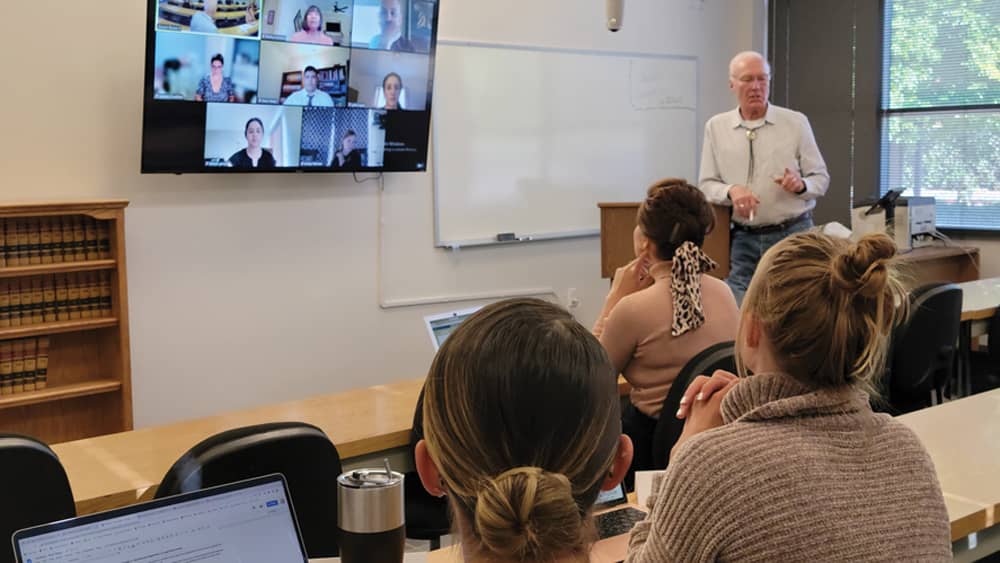
Academic College Degree Education Insight Concept

The coronavirus pandemic, economic instability and high gas prices have shaken local institutes of higher education. Yet North Bay colleges and universities are using advanced technologies, student feedback and new course offerings to meet students’ needs. They are also committing more resources to purchase computer equipment and hire therapists to ensure students’ success.
“Convenience was a recurring theme from students during the pandemic. Many students also have expressed a real desire to return to campus. We are planning to offer a broad array of classes both in person and remote this fall. All of our offices are open on campus to serve our students and community. We are all excited to welcome students back to SRJC,” says Frank Chong, Ed.D., president of Santa Rosa Junior College.
Higher education’s ability to provide meaningful online courses and opportunities is among the most significant results of the pandemic, says Karen Moranski, provost and vice president of academic affairs at Sonoma State University. “SSU will offer 75% of classes in-person in fall 2022,” says Moranski. “The move is in response to student interest. We will continue to offer certain courses online. We are having strategic discussions to understand how online learning helps students overcome challenges like increased responsibilities at home or work.”
How online education helps
With more transmissible variants of COVID spreading during the summer, North Bay colleges and universities are aware that online education can be a way to ensure public safety. They are also hopeful the extended use of online classes and opportunities will stop the decline in enrollment.
The COVID-19 pandemic led to a sharp drop in the number of undergraduate and graduate students. Data from the National Student Clearinghouse Research Center show postsecondary institutions in the U.S. lost almost 1.3 million students since spring 2020. In spring 2022, postsecondary enrollment dropped by 4.1%, or 685,000 students.
Online education helps students by relieving the stresses of high gas prices, commuting and parking. It also assists students with anxiety issues and inexperience with in-person college-level courses. Students entering college, in college, and in advanced and professional degree programs need as much support as possible.
Data from the Centers for Disease Control and Prevention (CDC) show 37% of high school students reported experiencing poor mental health during the first year of the pandemic. Slightly more, 44%, felt persistently sad or hopeless in 2021. A survey by BestColleges.com revealed over 95% of college students experienced negative mental health symptoms due to the pandemic. Almost half, 48%, believed the mental health effects negatively impacted their education. A spring 2020 survey of graduate students found indications of anxiety rose by 50%. A spring 2020 survey of law students found 27% of the students experienced symptoms of major depressive disorder, while 37% of the students experienced symptoms of generalized anxiety disorder.
Roy Hurd, president of Empire College School of Law, says making contact with students and helping them access online courses are critical components of a school’s success. “We realized after the 2017 fires how important it is to reach out to students. The days following those fires was the first time we called every single student to check on them and see how they were doing. We did this again at the start of the pandemic. We listened to what they wanted. We want the experience of hybrid distance education to be absolutely seamless,” says Hurd.
Local students go despite challenges
Young adults have many reasons not to attend college this autumn. These include contracting the novel coronavirus from in-person learning or on-campus experiences. Students are also worried that they are not prepared due to the quality of education in spring 2020 and most of 2021.
Further, young adults are frustrated by COVID safety restrictions on in-person experiences at college campuses. Many young adults have taken on jobs to help their families meet expenses. Some are needed at home to assist younger siblings who fell behind academically during the pandemic. Tuition costs are higher than before, and it can be difficult to find housing at (or near) a four-year institution.

Young adults from the North Bay experience unique concerns specific to the region and its demographics. These include not receiving adequate financial assistance because of undocumented status, having to repay or assist with family expenses related to smoke and fires, fulfilling requests to assist with family businesses that lost workers, and comparatively high gas prices.
Despite all of these worries, numerous graduates of some North Bay high schools will attend two-year and four-year colleges this fall.
Matt Moore, a school counselor at Terra Linda High School in San Rafael, says roughly the same number of 2022 graduates will be going to four-year institutions in the fall as in 2019. “That’s about 55% of our graduating class. Between 30 to 35% of our graduates will go to a community college,” says Moore.
The choices recent graduates have made show their strength and the level of assistance they received from high school faculty and staff during the pandemic. “Our school’s outreach and flexibility helped many students graduate this year,” he says. “Though this year’s admissions cycle was difficult for many, Terra Linda High students were admitted to a variety of competitive schools, ranging from UCLA and USC to the College of Marin.”
It is important for high schools to provide support that is specific to students’ cultural backgrounds. “The student body of Terra Linda High School is roughly 50% Latinx. Latinx families were disproportionately affected by the pandemic,” says Moore.
This was especially true for families with household earners who were undocumented. Many undocumented individuals lost employment during the pandemic. All were ineligible for federally-boosted unemployment benefits. In addition, nationally, more than 4 in 10 Latinx students will be the first in their family to attend college.
According to Moore, Terra Linda High School teachers and staff worked hard to help students stay motivated in the face of economic uncertainty and a lack of familiarity with the application process. Changes in college admissions policies helped some students, but hurt others.
“Students benefited from schools in the California State University system and University of California system dropping the need to take the SAT and ACT tests,” says Moore. “But because this requirement was dropped, more students applied. Colleges had a difficult time processing the flood of applications. This led to some students not getting into the schools they expected.”
Rachael Kobe, school counselor at Tomales High School, says the story was slightly different for students in rural areas like West Marin. “More of our 2022 graduates chose to pursue a certificate program or community college than [enter] a four-year institution. Many didn’t feel ready to take that jump. It’s because they saw 2020 as a lost year. You could see and feel the impact of losing their junior year,” says Kobe.
According to Kobe, recent graduates are also concerned that the 2020 household incomes they stated on their Free Application for Federal Student Aid (FAFSA) have now changed. “The aid they are getting for the 2022-2023 academic year is based on their household income from 2020,” she says. “[The aid amounts may] have differed due to the uncertainty of the pandemic. Students may have gotten loans, work study jobs, or grants they don’t feel they will get again next year. Since their parents are working again, students hope to see an award amount that is more certain.”
A tale of three students
The paths of three 2022 graduates of Napa High School reveal how factors such as affordable housing make a difference.
Melina Sanchez, 18, originally planned to attend a four-year university. She applied to four California State University schools and six University of California schools. After sifting through acceptance letters, she decided to study film at San Francisco State University. “I didn’t get housing. It’s not guaranteed for freshmen. I don’t have the money to pay rent, parking and gas prices to live in San Francisco,” she says.
Sanchez has now chosen to study culinary education and small business management at Napa Valley College. “I will still go to a four-year university, but later. I need to plan and organize right now,” she says.
Jazmyn Bell, 17, applied to 30 colleges and universities. She was admitted to approximately 20% of the schools to which she applied. She will be on a pre-health track at the University of California, Santa Barbara this fall. “I’ve wanted to go into medicine for a really long time, even before the pandemic,” says Bell. “But I must protect myself from COVID. I will be taking as many online courses as possible to stay safe. Online education in high school during the pandemic helped prepare me for that.”
Dayron Yahir Solis, 18, is a first-generation college student. He will study structural engineering at the University of California, San Diego this fall. “From the start, it was unclear where the money would come from,” says Solis. “During the pandemic, my mother got less work. I was unclear about how to apply for financial aid because I am undocumented.”
Solis originally thought he would attend Napa Valley College. “A week before the decision date, I got a notice from the state,” he says. “Since I had lived in California for so long, I would be allowed to pay the in-state tuition rate. That and the quality of the engineering education at UCSD are the main reasons I chose to leave Napa.”
Online education expands reach
Online education has permanently changed higher education by allowing schools to accept students far from campus.

Empire College School of Law used to have students who were based primarily in Sonoma County. Today, students from as far north as Eureka and as far south as San Francisco attend the college. “It’s partly due to our new OWL lab equipment to facilitate synchronous online learning. (Synchronous online learning takes place online at the same time that it does in the classroom.) Once a person talks, the camera turns immediately to that person, whether they’re in class or at home. The equipment cost approximately $5,000 per classroom. We outfitted seven classrooms for online learning,” says Hurd.
Cassidy Jourdan, a third-year law student at Empire College of Law, says she only met one classmate in person in the academic year 2021-2022. “However, the benefits of online schooling have allowed me to participate in class throughout fire evacuations and the ongoing pandemic. The pandemic also solidified my area of focus, [which is] assisting people with their end of life documents,” says Jourdan.
Michael “Miko” Mallonga, a fourth year law student at Empire College of Law, says taking classes online allowed him the flexibility to do an internship at a firm in Santa Rosa. “I was also able to travel for personal reasons, to visit family in the Philippines,” he says. He adds that he hadn’t seen them for close to two years because of the pandemic.
This fall, Santa Rosa Junior College will offer 65% of its classes in-person and 35% online. “Prior to the pandemic, we offered only 10% [of classes] online. We are still waiting to see what the enrollment trends will be this fall when comparing online versus in-person,” says Josh Adams, dean of academic affairs at SRJC.
SRJC measured student interest in online education by surveying 15,443 students in spring 2022. The survey found asynchronous courses, courses that were available online at times other than they would have been held in-person, have become more popular since the start of the pandemic. More than 60% of students who were uncomfortable with online courses before the pandemic became comfortable with them. SRJC students say work schedules and family responsibilities were the primary external factors that influenced enrollment.

When SSU surveyed its students, students shared they experienced severe economic impacts from the pandemic. “Students say they had to work more—sometimes two to three jobs to help their family pay bills during the pandemic. This is part of the reason online education was so helpful to them. The fact that pandemic conditions have eased is part of the reason we’re returning to more in-person education,” says Moranski.

SSU students also say they needed help understanding the total cost of education. “In response, SSU completely redesigned the financial aid notification process and materials. Now students get a separate award pamphlet that explains their financial aid package and the cost of attendance. We’ve gotten good feedback on it so far,” says Moranski.
Helping students to clarify the cost of college and understanding financial aid can boost college enrollment, says Anna McGee, the student support and wellness coordinator for Novato Unified School District.
“The financial impact of COVID has created financial uncertainty. For some, it’s therefore impacted student confidence when it comes to making a commitment to four-year institutions right out of high school. This is particularly true for some our first generation and/or undocumented students who have worked very hard to achieve at a high level, yet may not have access to financial aid resources,” says McGee.
Ana Andrilla, interim assistant principal at Napa High School, says it is problematic that some colleges send information about students’ financial aid in late March or early April.
“This was true even before the pandemic. I’ve seen students get information in early April. They’re expected to let colleges know their decision by May 1,” says Andrilla.
Making decisions is particularly difficult for local students who were displaced or severely economically affected by COVID and wildfires. “This is part of the reason that mental health services at the high school and college level are so critical in college enrollment,” she says. “A plus from Napa High School holding events like a mental health fair is showcasing the need for more professionals in this field. I’ve now heard from more students who want to become therapists, social workers and employees of nonprofits in the ‘helping professions.’”
A shift in student interests
Nationwide, the pandemic has caused more students to apply to public health programs. Applications jumped 23% in March 2020. They jumped again by 40%, with more than 24,000 prospective students, in March 2021.
New offerings at local colleges have attracted interest as well. Since 2020, SSU has added an education minor, a new concentration in composition, a bachelor’s degree in physical science, and online master of arts programs in educational leadership and early childhood education.
Dominican University offered a course in COVID-19 contract tracing, which included an internship assisting Marin County Health and Human Services. SRJC is launching a new ethnic studies department in fall 2022. It is also adding courses in business administration, construction management, cybersecurity, drone studies, network security administration and web full-stack development.
Students’ interests and colleges’ responses to them will continue to shift as the pandemic alters the economy, says Robert Eyler, Ph.D., professor of economics at Sonoma State University.
“Expect to see more aggressive marketing and a tailoring of courses to student interests,” says Eyler. “To a certain extent, this is still fallout from the Great Recession. Students have heard older generations question the return on investment for a degree.”
With most COVID restrictions gone, students are asking how colleges and universities can connect them to employers.
“Colleges’ grant of access to employment and internship opportunities is critical. This is especially true for college graduates who want to stay local,” says Eyler.
Eyler says recent high-school graduates will also make decisions about entering college based on the threat of a recession. In June and July, numerous companies announced layoffs and hiring freezes.
“In the pandemic, young adults saw the federal government offer support through unemployment benefits,” says Eyler. “They know that relief will not be there this time around. It’s a safe bet that a college degree will enhance job prospects as the economy improves.”
Which Degrees Pay Off the Most and Fastest?
Engineering degrees are the best investment for a bachelor’s degree. The top highest paying majors include:
Computer engineering, with the highest median wage at $74,000
Computer science, aerospace engineering, electrical engineering, and chemical engineering, all at $70,000
Industrial engineering, at $69,000
Mechanical engineering, at $68,000
Miscellaneous engineering, at $65,000
Civil engineering, at $63,000
General engineering, at $62,000
For non-engineering degrees, the highest paying majors, in order, are economics, construction services, business analytics, and finance, all at $60,000, and physics, at $55,000. The data come from the Federal Reserve Bank of New York, from May 2022. They pertain to individuals between the ages of 22 and 27 who earned a bachelor’s degree.
Information about the fastest-growing occupations is also relevant. The 2018 pre-pandemic list from the U.S. Bureau of Labor Statistics (BLS) predicts the most job openings for individuals with bachelor’s degrees in business, community and social service, engineering and architecture, finance, health care and science, information technology, management-related careers, sports, communication, and design and teaching.
A 2020 pandemic-period list of the fastest growing occupations excluding pandemic recovery also comes from the BLS. It predicts a significant number of job openings for nurse practitioners, information security analysts, data scientists, and physician assistants, all with median annual wages above $100,000. Jobs in these careers may require more than a bachelor’s degree.




